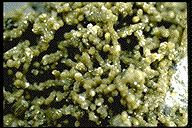

- Chemistry: Mg6Fe2CO3(OH)16 - 4H2O, Hydrated Magnesium Iron Carbonate Hydroxide.
- Class: Carbonate.
- Group:
Manasseite . - Uses: Only as mineral specimens.
Specimens
Sjogrenite is dimorphous with the mineral pyroaurite. Dimorphs are minerals that share the same chemistry but have different structures. Sjogrenite is a hexagonal mineral, while pyroaurite is a trigonal mineral.
PHYSICAL CHARACTERISTICS:
- Color is usually white, yellowish, brownish, greenish to off-white.
- Luster is vitreous to pearly.
- Transparency: Crystals are usually translucent to transparent.
- Crystal System is hexagonal; 6/m 2/m 2/m.
- Crystal Habits include tabular, scaley to platy crystals; also found in fibrous forms.
- Cleavage is perfect in one direction (basal).
- Hardness is 2.5.
- Specific Gravity is 2.1 (very light).
- Streak is white.
- Associated Minerals includes
tetra-ferriphlogopite , dolomite, pyroaurite, calcite, forsterite, brucite,ludwigite and serpentine. - Notable Occurrences include the type locality of
Langban , Varmland, Sweden as well as Sterling Hill, New Jersey; Healdsburg, Sonoma County, California, USA and at Kovdor, Kola Peninsula, Russia. - Best Field Indicators are crystal habits, cleavage, color and locality.








